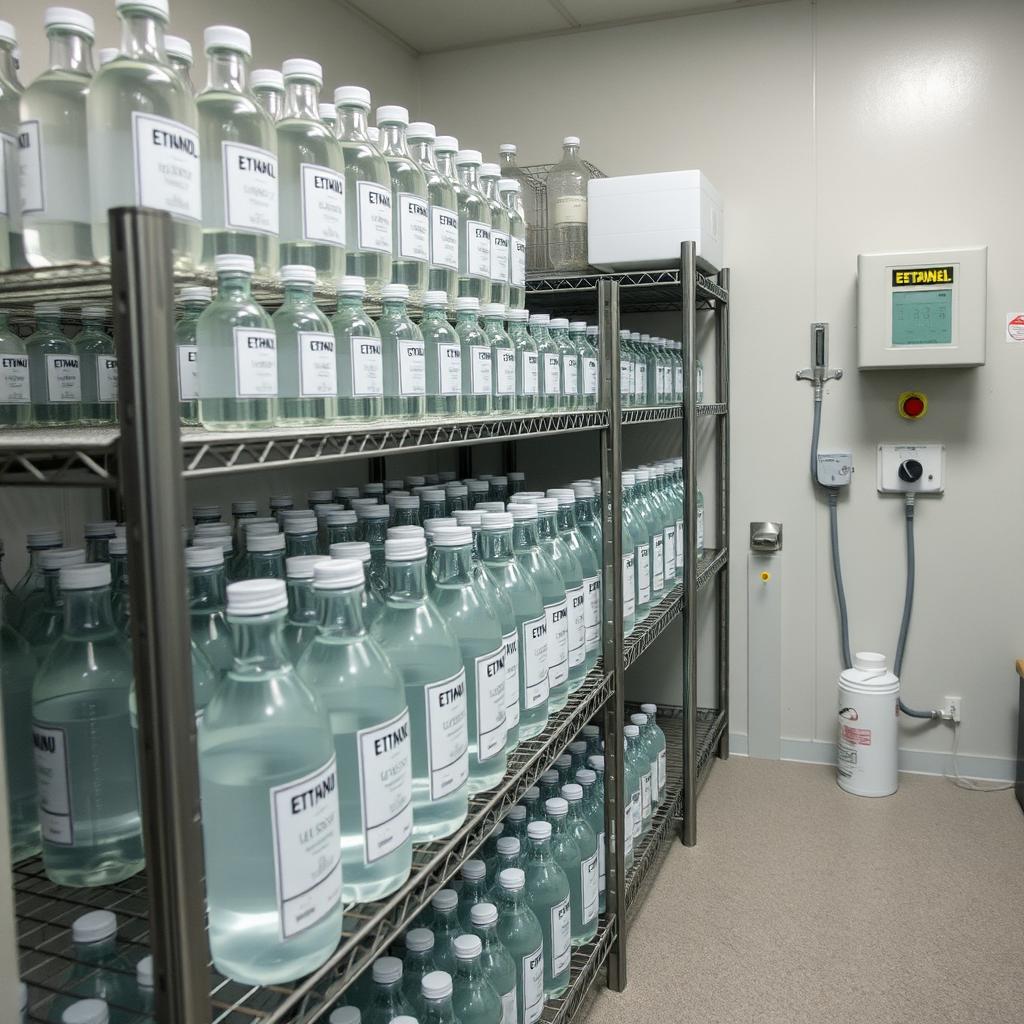What factors affect ethanol’s storage and shelf life? How can we keep its quality over time? This question is key for industries that use ethanol. Ethanol storage is complex, needing careful thought to keep it good and last long. Several things influence ethanol’s storage and shelf life. These include storage conditions, how it’s handled, and upkeep. To keep ethanol quality high, industries must plan and execute storage well. This prevents damage and keeps it safe.
Click to use Silverigroup personal shopper services
Key Takeaways:
- Understanding ethanol’s storage and shelf life is key for industries that use it.
- Ethanol storage needs careful thought, including storage conditions and handling.
- Many factors affect ethanol’s storage and shelf life, like temperature, humidity, and light.
- Good maintenance and handling are crucial to avoid ethanol damage and contamination.
- Ethanol storage is important in many industries, including pharmaceuticals, cosmetics, and food.
- The quality and longevity of ethanol depend on proper storage and handling.
Click to buy citric acid from Silvairgroup
Understanding the Properties of Ethanol
Ethanol is a liquid that can catch fire easily and evaporates quickly. It has many uses. To keep it stable and preserved, knowing its properties is key. Its chemical makeup and traits are important for how it’s stored and how long it lasts. Things like its boiling point, how flammable it is, and how well it mixes with other liquids matter. These aspects guide how we store and handle it. For example, because it’s so flammable, we must be extra careful when we deal with it.
Chemical Composition and Characteristics
The makeup of ethanol is vital for its stability. Its molecular structure and properties influence how it reacts with other substances. Knowing these details is crucial for keeping ethanol in good condition and ensuring it works well in different uses.
Click to buy Citric Acid Anhydrous from Silvairgroup
Physical Properties Affecting Storage
Ethanol’s physical traits, like its boiling point and thickness, affect how it’s stored. For instance, its low boiling point means we need to keep it cool to stop it from evaporating or breaking down. The right storage conditions are essential to keep ethanol stable and prevent contamination.
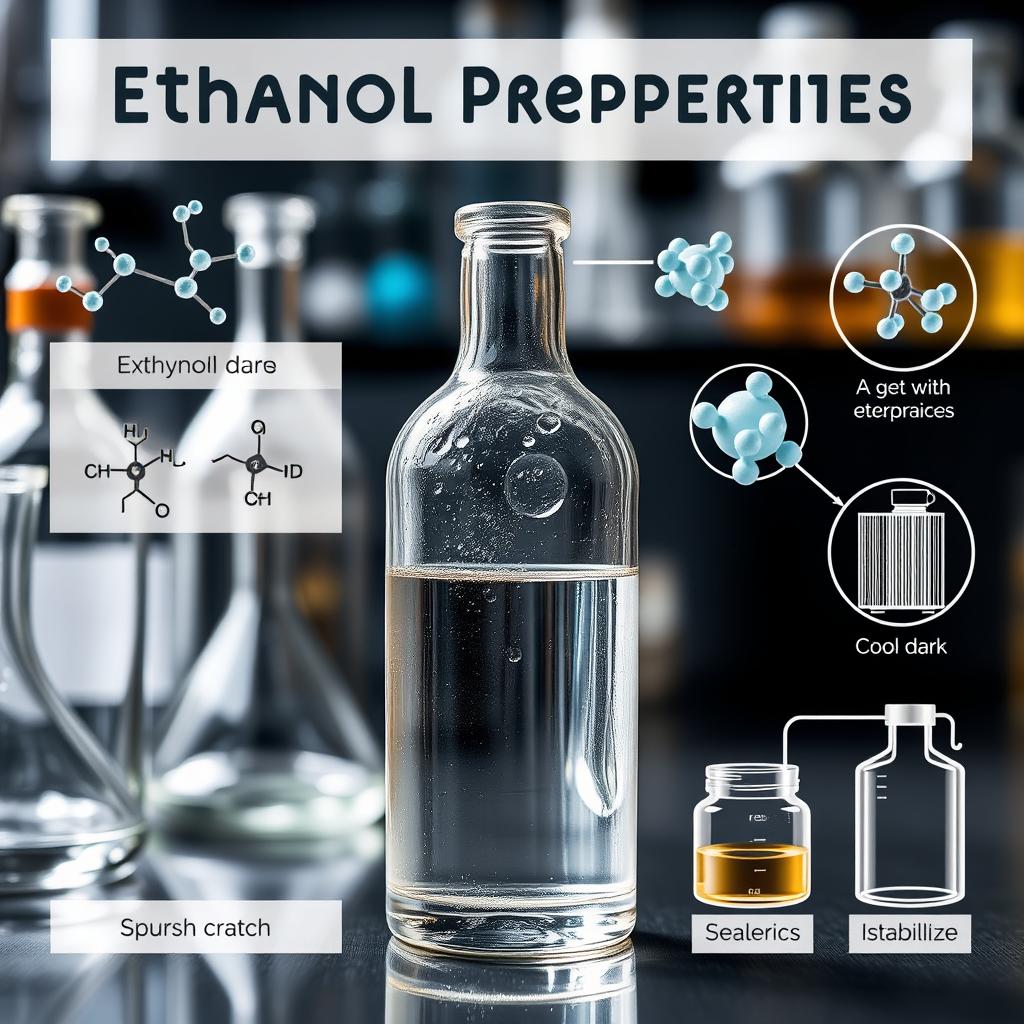
Common Uses and Applications
Ethanol is used in many fields, like medicine, beauty products, and biofuels. It’s used as solvents, cleaners, and fuel additives. Keeping it well-preserved and stored is important to ensure its quality and effectiveness in these roles.
Click to buy liquid Citric Acid from Silvairgroup
Factors Affecting Storage and Shelf Life of Ethanol
Many things can change how long ethanol lasts, like the weather, dirt, and how we handle it. Temperature changes and light can make ethanol go bad faster. To keep ethanol good, store it in a cool, dark spot. Keep it away from sunlight and heat. Also, dirt or water in ethanol can make it last less time. Use the best containers and materials that work with ethanol. Handling it right, like keeping it away from air and moisture, is key to keeping it fresh.
- Temperature control: storing ethanol at a consistent temperature between 60°F and 80°F (15°C and 27°C) can help slow down degradation
- Humidity control: maintaining a relative humidity of 50% or less can help prevent moisture from entering the container and contaminating the ethanol
- Light protection: storing ethanol in a dark or shaded area can help prevent light-induced degradation
Knowing these factors and how to deal with them helps keep ethanol good for longer. This way, we can make sure ethanol stays useful and effective for its job.
| Factor | Effect on Ethanol |
|---|---|
| Temperature fluctuations | Can cause degradation and reduce shelf life |
| Exposure to light | Can cause degradation and affect quality |
| Impurities | Can contaminate ethanol and reduce its usability |

Optimal Storage Conditions for Ethanol
Storing ethanol right is key to keeping it good and lasting longer. Good ethanol storage solutions mean watching temperature, humidity, and light. These steps help stop ethanol from getting spoiled or contaminated. Knowing how each factor works is important. Temperature affects ethanol storage a lot. Too hot or cold can damage it. Also, keeping humidity low stops bad stuff from growing.
Temperature Requirements
The best temperature for ethanol is between 60°F and 80°F (15°C and 27°C). This keeps it from breaking down too fast and stops bad bugs from growing.
Click to buy frozen a grade beluga fish from Silverigroup
Humidity Control
Keeping humidity at 50% or less is best. This stops bad bugs and keeps ethanol clean. You can use desiccants or dehumidifiers to do this.
Light Exposure Considerations
Light can also harm ethanol, especially in clear containers. To protect it, store ethanol in dark containers or use special packaging that blocks UV rays. By following these tips and using good ethanol storage methods, you can keep ethanol quality high. This means less chance of it getting spoiled or contaminated.
Selecting the Right Storage Containers
Choosing the right container for ethanol is key for keeping it safe and effective. There are many options, and the best one depends on how much ethanol you need and where you’ll store it. It’s important to store ethanol properly to avoid contamination and damage.
Materials like certain plastics, glass, and metals are good for storing ethanol. Here are some important things to think about when picking a container:
- Size: The container should be big enough for the ethanol you need.
- Shape: The shape can make it easier to handle and store the container.
- Durability: The container must be strong enough to handle storage and handling well.
Container Specifications and Seal Requirements
It’s important to consider the container’s specs and seal needs. A good seal helps keep the ethanol from evaporating and getting contaminated. Here are some key things to look for in a seal:
| Container Type | Seal Requirement |
|---|---|
| Plastic Containers | Tight-fitting lids or screw-top caps |
| Glass Containers | Rubber stoppers or glass lids |
| Metal Containers | Welded or soldered seams |

Safety Measures for Ethanol Storage
Storing ethanol safely is crucial because it can catch fire easily. To keep it stable and safe, several steps are needed. First, make sure there’s good air flow to stop vapors from building up. Also, having fire alarms and systems ready is key. It’s important to handle ethanol carefully to avoid spills and accidents. Wear gloves and goggles, and keep the area bright and clear. Make sure containers are labeled right to avoid mistakes. Having a plan for emergencies can also help a lot.
To keep ethanol stable, follow the right storage and handling steps. Store it in a cool, dry spot, away from heat and flames. Check the storage area and containers often to spot and fix any dangers. These steps help keep ethanol safe and prevent accidents. Some important safety steps for ethanol storage include:
- Proper ventilation to prevent vapor buildup
- Fire prevention strategies, such as fire alarms and suppression systems
- Handling precautions, such as wearing personal protective equipment
- Proper labeling of containers
- Emergency response planning
By focusing on ethanol storage safety, we can avoid accidents and keep the ethanol stable.
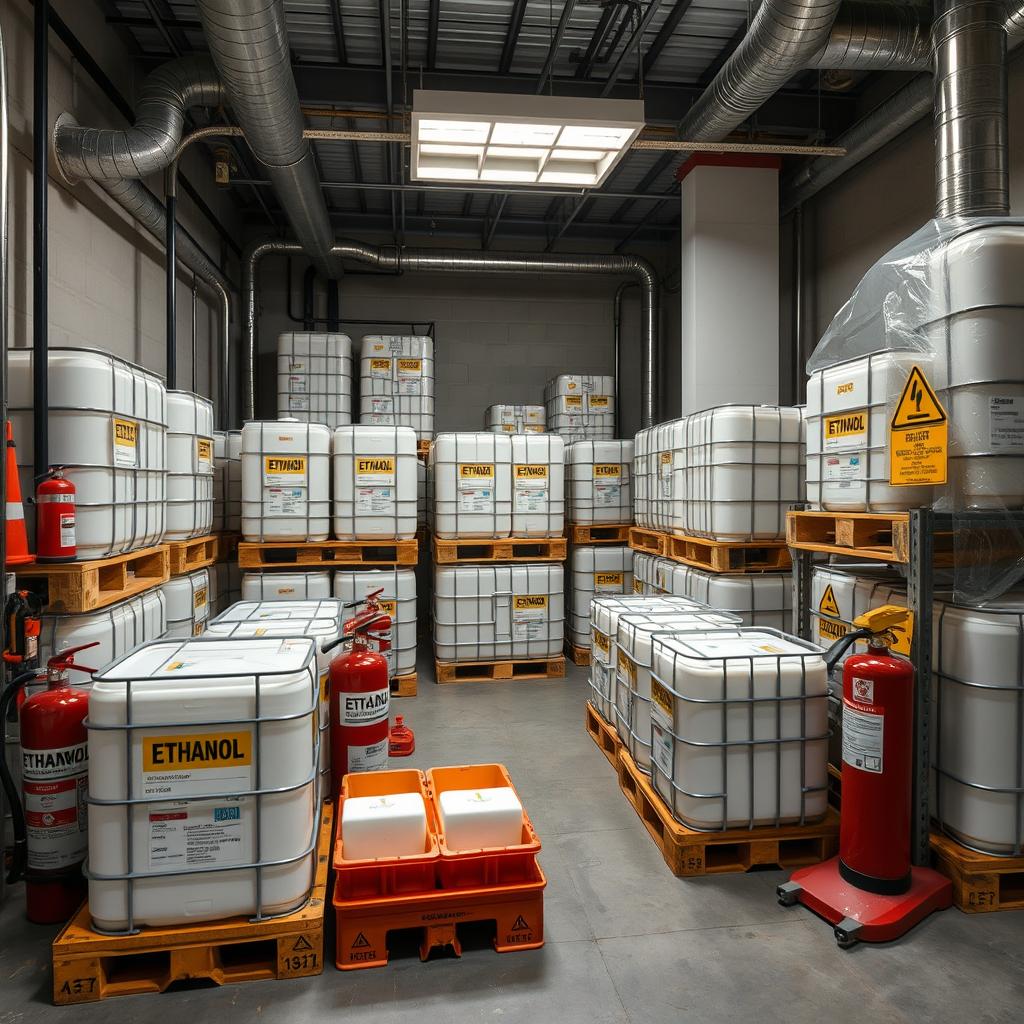
Environmental Considerations in Ethanol Storage
Storing ethanol requires careful thought about the environment. Good ethanol storage solutions keep it safe and effective. This means controlling the temperature and humidity to prevent damage. It’s also key to have good ventilation. This stops fumes from building up and lowers fire risks. By thinking about these things, you can pick the best place to store ethanol.
Here are some important things to think about when storing ethanol safely:
- Climate control needs, like keeping the right temperature and humidity
- Good ventilation to avoid fumes and fire risks
- Choosing a location wisely, considering safety and the environment
By focusing on these environmental aspects, you can keep ethanol in top shape. This helps protect it and reduces harm to the environment. It’s all about preserving ethanol for the long term.
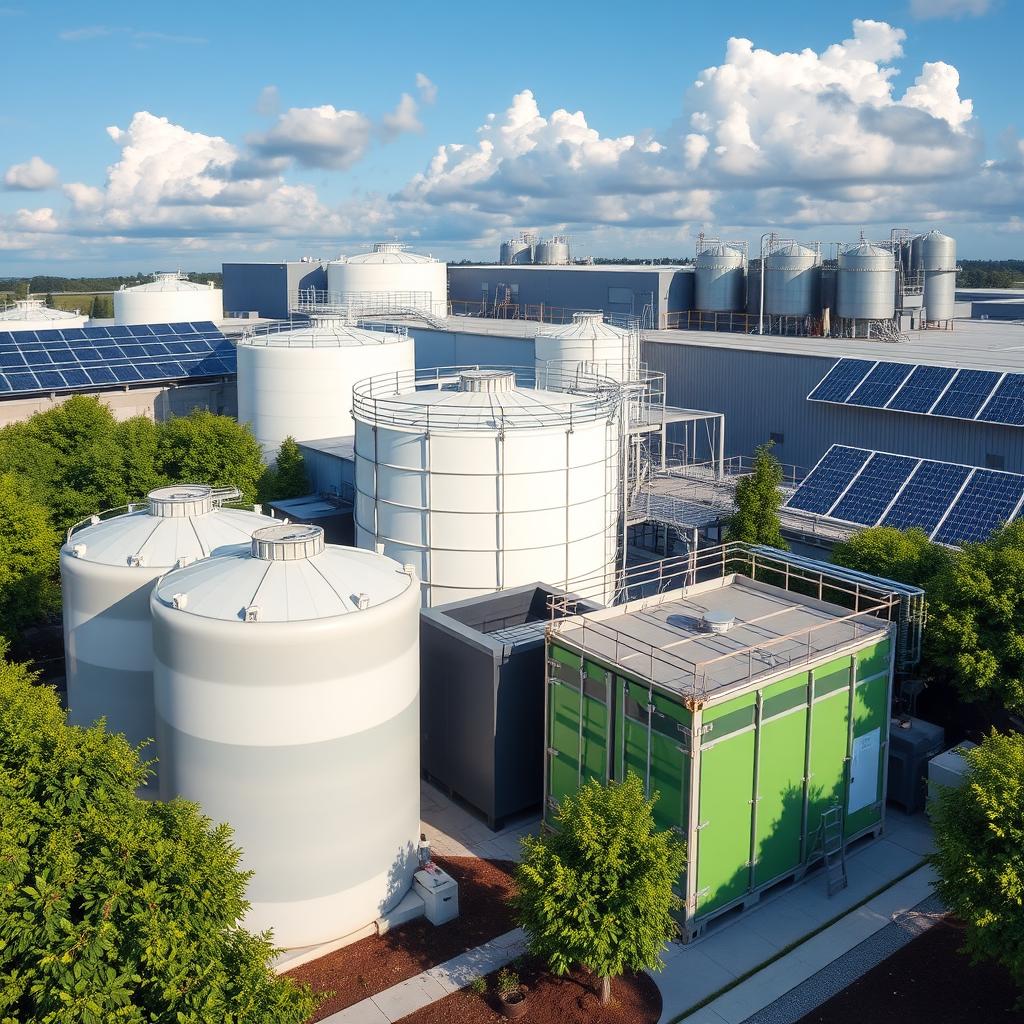
Signs of Ethanol Degradation
It’s important to know the signs of ethanol degradation to keep it safe and good quality. Ethanol can degrade due to storage, environment, and how it’s handled. These factors can change its color, smell, or how thick it is. Some common signs of ethanol degradation include:
- Discoloration: Ethanol may turn yellow or brown due to oxidation or contamination.
- Unpleasant odor: Ethanol may emit a strong, unpleasant smell due to the formation of aldehydes or other compounds.
- Viscosity changes: Ethanol may become thicker or thinner due to the formation of polymers or other substances.
These changes happen because of chemical reactions like oxidation and microbial growth. Things like temperature, humidity, and light can make these changes happen faster. By watching for these signs and acting fast, you can stop further damage and keep your ethanol safe.
Checking your ethanol regularly is key to spotting degradation. Look at its color, smell, and thickness. Also, test for any bad stuff. By being proactive, you can stop ethanol from degrading and keep it good for longer.
| Signs of Ethanol Degradation | Description |
|---|---|
| Discoloration | Change in color due to oxidation or contamination |
| Unpleasant odor | Strong, unpleasant smell due to the formation of aldehydes or other compounds |
| Viscosity changes | Change in thickness or thinness due to the formation of polymers or other substances |
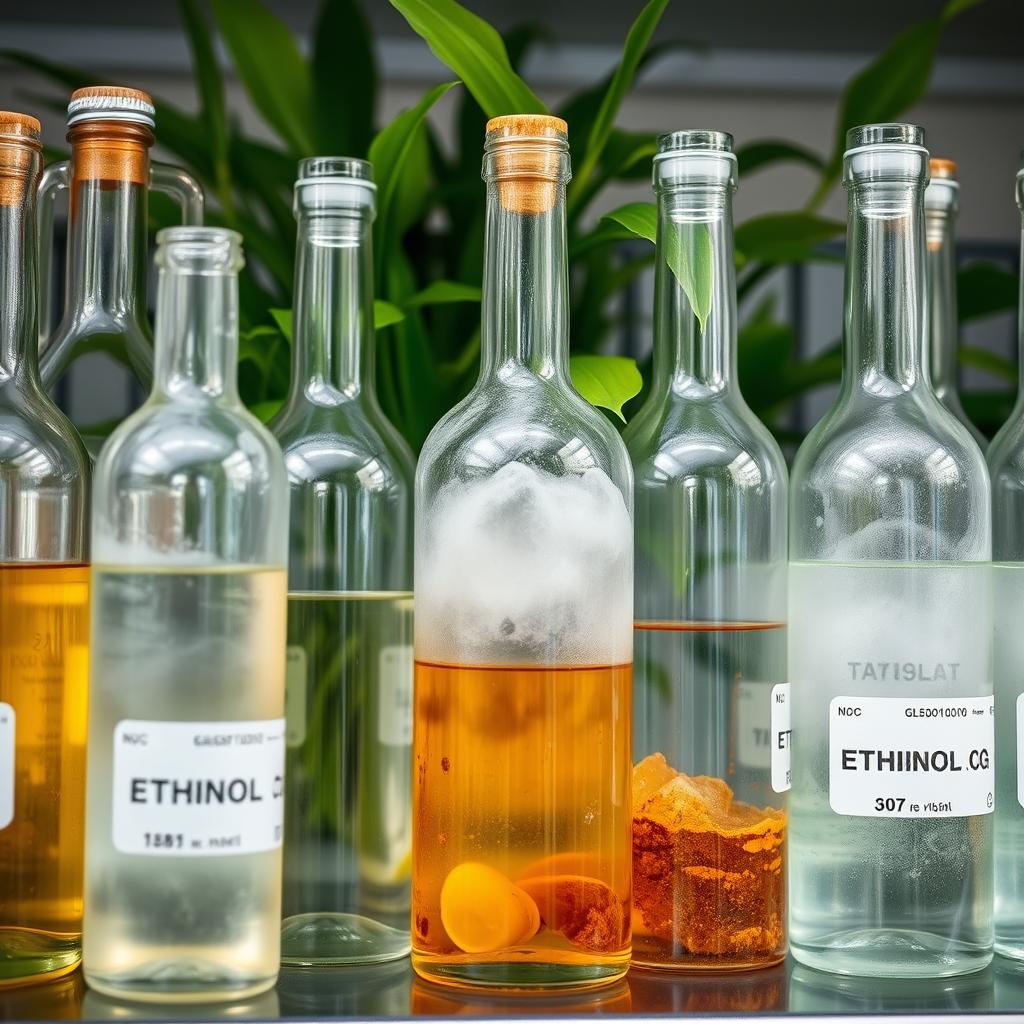
Best Practices for Long-term Storage
To keep ethanol fresh for a long time, it’s key to follow some important steps. These include regular maintenance, quality checks, and keeping records. This way, you can make sure your ethanol stays safe and of good quality. It’s important to check and clean your storage area often. This keeps it clean and safe from contamination. Also, using ethanol storage solutions can make the storage even better.
Maintenance Protocols
- Regularly inspect storage areas and containers for signs of damage or wear
- Clean and maintain storage equipment to prevent contamination
- Implement a schedule for routine maintenance and inspections
Quality Control Measures
It’s vital to test and analyze the ethanol regularly. This checks if it’s still good to use. You should look at its chemical makeup and physical state.
Documentation Requirements
Keeping good records is crucial for managing ethanol well. This includes tracking what you have, safety information, and logs of storage conditions. By sticking to these best practices, you can keep your ethanol safe and fresh. This helps prolonging ethanol shelf life and ensures you have effective ethanol storage solutions.
Industrial vs Laboratory Storage Requirements
Storage needs for ethanol differ a lot between industrial and lab settings. Each place has its own challenges. In big industries, moving and storing ethanol in bulk is key. They need special gear and places to keep ethanol safe.
In labs, keeping ethanol pure and stable is a must. They need tight control over how it’s stored. This ensures the ethanol stays good for research. In big industries, ethanol storage places must handle lots of ethanol. They need to control temperature, humidity, and air flow well. This keeps the ethanol from getting bad.
Labs, however, need small, special places to store ethanol. These places must keep the storage conditions just right. Some main differences in storage needs are:
- Volume: Big industries need big storage, labs need small, special ones.
- Purity: Labs want very pure ethanol, but industries are okay with less.
- Rules: Both must follow rules, but the rules can be different.
Knowing these differences helps people store ethanol right, whether in big industries or labs. Keeping ethanol storage and ethanol stability up is key. It makes sure ethanol is good quality, no matter where it’s stored.

Common Storage Mistakes to Avoid
Storing ethanol properly is key to keeping it fresh and usable. Many mistakes can harm the quality of ethanol. It’s vital to know how to preserve ethanol and the dangers of bad storage.
Common errors include mishandling ethanol, like using the wrong transfer methods or risking contamination. Problems with the storage environment, like bad temperatures or wrong materials, can also damage ethanol. Not keeping proper records can lead to legal issues or safety risks.
Handling Errors
When moving ethanol, mistakes can happen. These can cause spills, contamination, or other problems. To prevent these, it’s crucial to handle ethanol correctly and use the right materials for storage and moving.
Storage Environment Issues
Problems with the storage area can also harm ethanol. Bad temperatures, humidity, or light can damage or contaminate it. To avoid these, store ethanol in a controlled area with the right temperature, humidity, and light.
Documentation Oversights
Not keeping good records can cause legal trouble or safety issues. It’s important to document ethanol storage well. This includes the date, time, and conditions of storage. Such records help spot problems and ensure you follow the law.
By avoiding these common mistakes, you can keep your ethanol in top shape. Proper storage and care are essential for ethanol’s quality and shelf life. Following best practices helps avoid contamination, damage, or other problems.
| Storage Mistake | Potential Consequence |
|---|---|
| Handling Errors | Contamination, spills, or accidents |
| Storage Environment Issues | Degradation or contamination of ethanol |
| Documentation Oversights | Regulatory non-compliance or safety hazards |
Conclusion: Ensuring Optimal Ethanol Storage and Longevity
The storage and shelf life of ethanol is key to keeping it effective. Knowing ethanol’s unique traits and using ethanol storage solutions designed for it helps. This way, organizations can keep ethanol stable and working well for a long time. Controlling temperature and humidity and choosing the right containers are important. Every step in handling ethanol helps keep it strong and safe. By avoiding mistakes and following best practices, businesses can save money and improve safety.
Remember, keeping detailed records, checking quality, and doing regular maintenance are crucial. These steps help ensure your ethanol stays in top shape. This way, your products or projects will keep up with changing needs in your field.
FAQ: Storage and Shelf Life of Ethanol
What factors affect the storage and shelf life of ethanol?
Several factors can impact ethanol’s storage and shelf life. These include temperature changes, light exposure, air contamination, impurities, and the materials used in storage containers.
What are the optimal storage conditions for ethanol?
The best storage conditions for ethanol include a specific temperature range and controlled humidity. It’s also important to minimize light exposure. Proper ventilation and choosing the right container are key to keeping ethanol quality and stable.
How can I select the right storage containers for ethanol?
When picking storage containers for ethanol, choose materials like certain plastics, glass, or metals. The containers should fit specific size, shape, and sealing needs. This prevents evaporation and contamination.
What safety measures should be taken when storing ethanol?
Storing ethanol safely is crucial because it’s flammable. Ensure proper ventilation and follow fire prevention strategies. Always handle it carefully. Labeling, emergency plans, and personal protective equipment are also vital.
How can I tell if ethanol has degraded during storage?
Signs of ethanol degradation include color, odor, or viscosity changes. Temperature and air exposure can speed up these changes. It’s important to monitor the ethanol and take steps to prevent further deterioration.
What are the best practices for long-term ethanol storage?
For long-term ethanol storage, follow maintenance and quality control protocols. Regular inspections, cleaning, testing, and inventory tracking are essential. These steps help keep ethanol supplies stable over time.
How do the storage requirements differ between industrial and laboratory settings?
Storage needs for ethanol differ between industrial and laboratory settings. Volume, purity, and regulatory compliance are key differences. Tailoring storage practices to the setting is crucial for proper handling and preservation.
What are some common mistakes to avoid when storing ethanol?
Common mistakes include handling errors and inadequate storage environment controls. Documentation oversights can also lead to regulatory issues or safety hazards. Avoiding these mistakes ensures ethanol is stored and preserved correctly.

